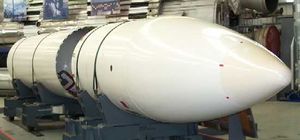Chevaline
(nuclear weapon) | |
|---|---|
 Chevaline mounted on a Polaris A3T missile | |
Chevaline was a system to improve the penetrability of the warheads used by the British Polaris nuclear weapons system. Devised as an answer to the improved Soviet anti-ballistic missile defences around Moscow, the system increased the probability that at least one warhead would penetrate Moscow's anti-ballistic missile (ABM) defences, something which the Royal Navy's earlier UGM-27 Polaris re-entry vehicles (RV)s were thought to be unlikely to do.
Chevaline used a variety of penetration aids and decoys to offer so many indistinguishable targets that an opposing ABM system would be overwhelmed attempting to deal with them all, ensuring that enough warheads would get through an ABM defence to be a reasonable deterrent to a first strike. The project was highly secret, and survived in secrecy through four different governments before being revealed in 1980.
The system was in service from 1982 to 1996, when the Polaris A3T missiles it was fitted to were replaced with the Trident D5.[1]
Development
The project was carried out in extreme secrecy by a team consisting of the Atomic Weapons Research Establishment (AWRE) at Aldermaston, the Royal Aircraft Establishment (RAE) at Farnborough, and Hunting Engineering at Ampthill, Sperry Gyroscope at Bracknell, Lockheed Aerospace in the United States, and others too numerous to mention, both in the US and the UK. The system was tested at the US Eastern Test Range, Cape Canaveral, and the warheads were tested with two full scale underground nuclear tests - 'UGT's - (Fallon UGT in 1974 and Banon UGT in 1976) at the Nevada Test Site. There were also numerous weapon effects tests to prove the RV/warhead resistance to the radiation-effects of the Galosh warhead; and there were numerous missile tests at the Woomera Missile Range, Australia, to develop various aspects of the RVs, the PAC and decoys. Recent declassifications of official files show that more than half the total project costs were spent in the United States, with industry and government agencies.
Hush hush
The Chevaline project was kept secret by successive UK governments, both Labour and Conservative. This secrecy was maintained under Harold Wilson, Edward Heath, Harold Wilson's second term and James Callaghan. The project was finally revealed in 1980 by Margaret Thatcher's then defence minister Francis Pym.
The reasons for revelation were both political and practical. The cost over-runs of the project were now so enormous (approximately £1 billion by 1979) that the secret inner-Cabinet spending approvals could not continue. The key decision to proceed had been taken in 1975, four years previously, and cancellation would be unlikely to save money at that point. Even if it were to be cancelled, a replacement would have to be ordered in any case. Shortly afterwards the Thatcher government decided that the successor system should be the Trident missile system and ordered the UGM-96 Trident I (C4 variant).[2]
Related Document
| Title | Type | Publication date | Author(s) | Description |
|---|---|---|---|---|
| Document:Whitehall Farce | book review | 12 October 1989 | Paul Foot | James Rusbridger: "Secrecy turns otherwise rational people into fascistic nutters; secrecy allows untold billions of pounds and endless energies to be wasted in unnecessary intelligence; secrecy pollutes the political process, muzzles what is left of the independent press and makes a mockery of Parliament and elections." |
References
- ↑ "UK/US BALLISTIC PAYLOAD CARRIER SYSTEM"
- ↑ Peter Hennessy, Cabinets And The Bomb p.278. Oxford University Press, 2007 ISBN 978-0-19-726422-5
Wikipedia is not affiliated with Wikispooks. Original page source here